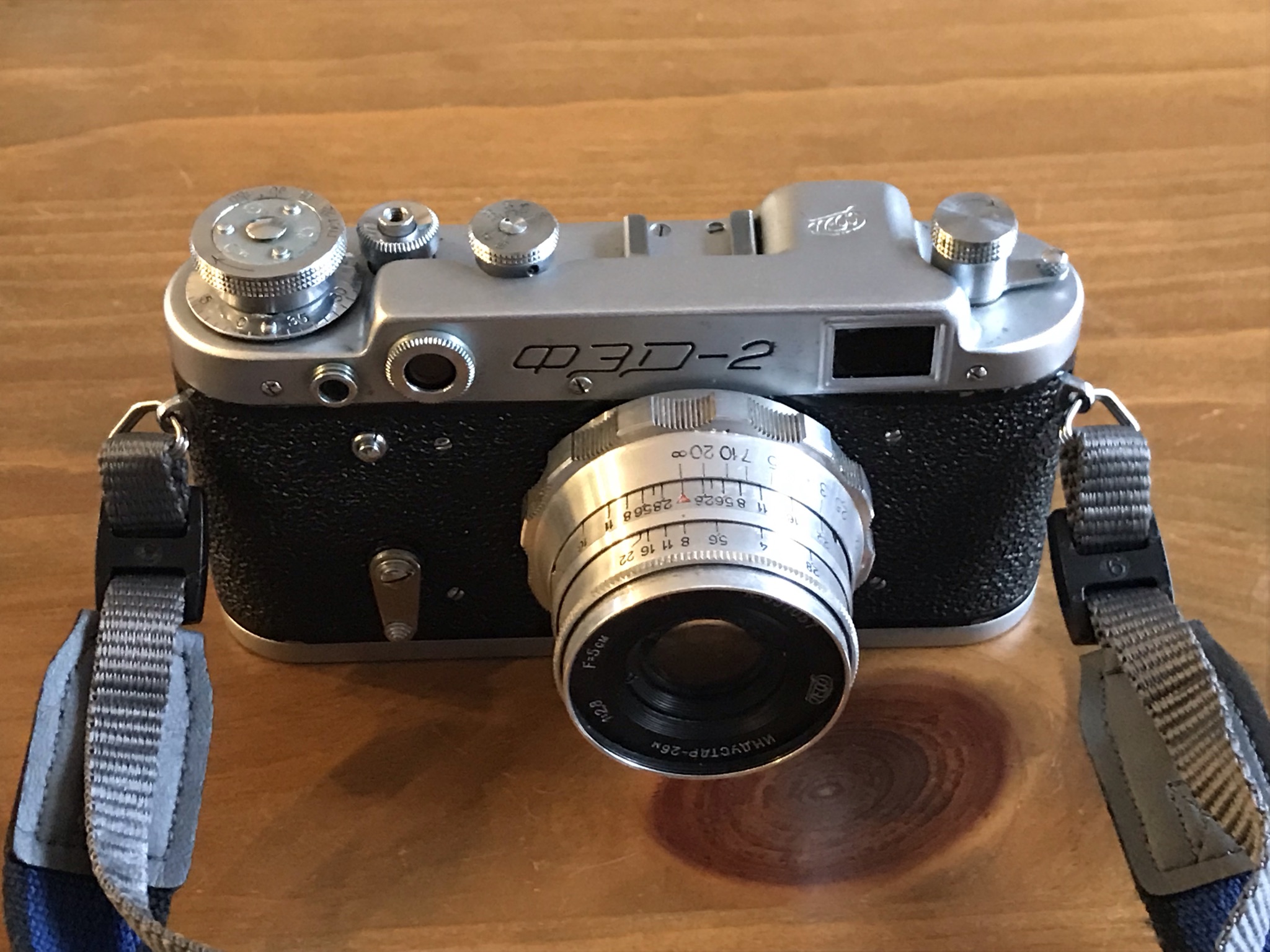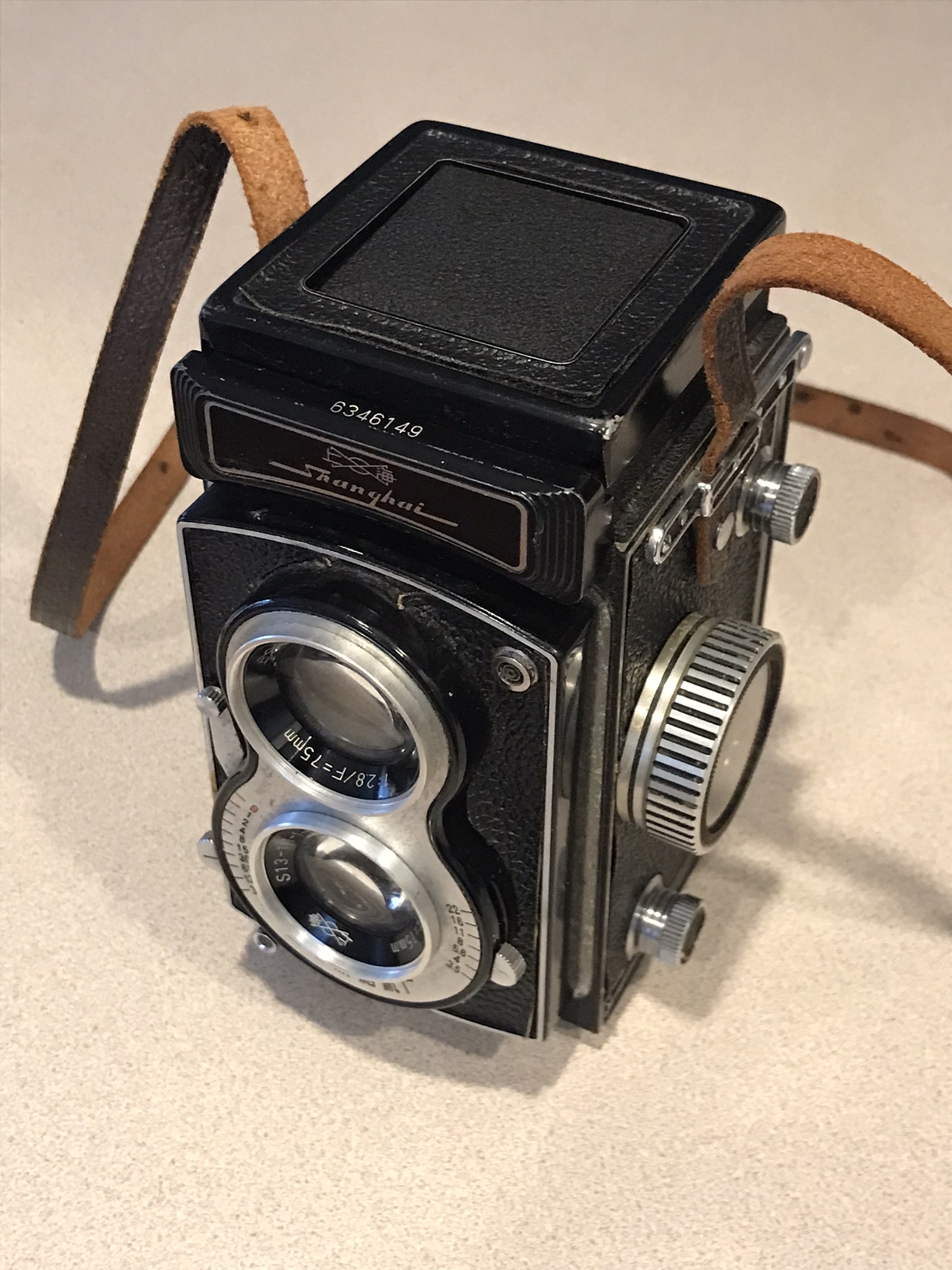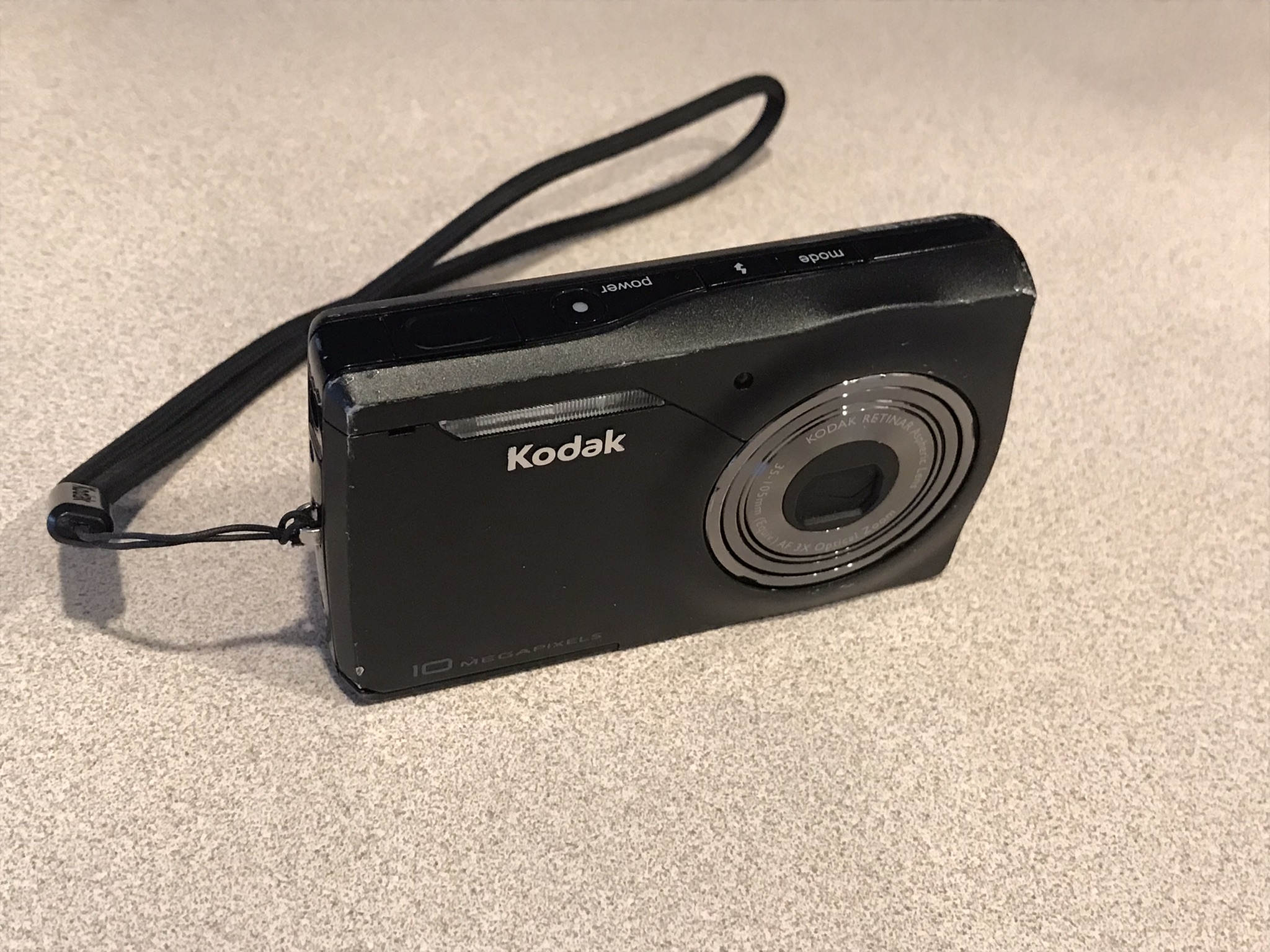Camera Collection
Inside the capsule, you find shelf upon shelf lining the walls.
On the shelf nearest to you, sits a collection of veritably ancient cameras.
« Return | Continue »
Page last updated December 2023.
Film
Mamiya Sekor 500TL
This was my first mechanical film SLR, which I bought from the Salvation Army thrift store for 50 dollars. Made in the mid to late 60s, it's a simple, all manual 35mm camera with pretty standard features for the time in a hefty brick-like package. With a good range of shutter speeds—from 1 second to 1/500th a second—and a clear, bright 50mm lens on a standard m42 mount with an f-stop range of 16 to 2, it fulfills most needs for amateur film photography. It comes with a through-the-lens light meter that is activated by pushing on the film rewind lever, a very convenient and handy mechanism that presents a great improvement over other clunkier, switch-based systems of the era. It's neither the prettiest nor the fanciest camera I have, but more importantly, it just works. All shutter speeds function correctly, all shutter mechanisms operate without flaw (the shutter makes a satisfying snap when released), the lens is still in great shape, and with one LR-44 battery and a single resoldered ground wire, its through-the-lens light meter has delivered very usable readings. And don't get me started on the history... All the scratches and markings on the camera might be a turn-off for some, but it reminds me that I'm holding a part of the past, and that this little machine has been a part of countless stories from countless people across the long decades. Because of this, and because of a lack of more enjoyable options, it's probably my favorite 35mm film camera so far.
Update: As of July 2023, this camera no longer works. RIP.
Canon Eos 30
A hand-me-down that I recieved in fully working condition, the Canon Eos 30 would be my preferred camera if I was a more practical person. A fully electronic device, it can do literally everything, at least within the limits of 35mm film. It has every automatic mode a photographer could want and then some, several segment displays and a fancy eye-focus system in its viewfinder, and takes care of most of the usual hassles of shooting film—namely, loading, rewinding, and cocking the shutter. However, that's the kind of thing that only turns me away. All that automation takes away the fun I get from film photography, not to mention that its unremarkable black plastic and rubber body feels uninspiring to use. What's the point of just pressing a button, if you could instead be fiddling with mechanical knobs and winding springs? I'll probably use the Eos 30 as a backup and for burst-exposure shots, but beyond that I'll stick to my older mechanical cameras.
Minolta Hi-Matic F
The story behind my Minolta Hi-Matic F is interesting. Well, interesting as in I pulled it out of a recycling bin, along with a Ricoh RW-1 point-and-shoot that I later sold for some quick cash. While the point-and-shoot was a relatively mundane find, the Hi-Matic F was far more interesting for me. Its aesthetic captured me immediately, its body being small enough to fit in a pocket but still carrying the timeless leatherette-and-steel construction found in other vintage cameras. Moreover, it was a rangefinder, and it was my first. Finally, after some online research, it turned out to be an intermediary model between earlier manual cameras and later point-and-shoots—it had manual focus, shutter cocking, and ISO setting, but automatic exposure. When I first found it the Hi-Matic F was, of course, broken, but after resoldering the battery terminals, re-aligning some internal springs, and stuffing a horrid amalgamantion of LR-44 batteries and aluminum foil in the battery compartment, it was ready to go. I've taken to using this thing as my day-to-day, slice of life camera, for when I want to take a quick shot without worrying about exposure or bulkiness, and so far it's produced great results for something that probably needed a CLA twenty years ago.
Asahi Pentax Spotmatic SP
Ahh, where to start with this one... I bought my Pentax Spotmatic on impulse. During one of my weekly visits to the thrift stores near my high school, I found this camera chilling in the back of Salvation Army's special finds cabinet. Mechanical film cameras are exceedingly rare in thrift stores around my area, so when I tested it and found its mechanisms working, I bought it for its low price of 50 dollars. However, the problems began after that. First, it took a model of battery that no longer existed, and while the button battery I bought for it was the right voltage, it only fit right side up, not upside down. Turned out, you had to put the battery upside down, with the ground facing out. The through-the-lens meter still worked, but its needle displayed a confusing reversed readout. The meter had other problems, too. I only found out after loading in film that if I left the meter switch on while releasing the shutter, the mirror would become stuck, and the only way to get it back down was to either release the meter switch while still holding down the shutter release, or taking (and wasting) another exposure. A few old forum threads agreed that this was a common age-related problem among this model of camera. In the end, although it has a better lens than my Mamiya Sekor 500TL, goes up to 1/1000th a second, and weighs a little less, I don't see myself using it much until I can afford to get it CLA'd.

FED-2D
I've had my eye on this one for months. Back when I was new to film photography, I wanted a fancy vintage Leica, one of those 1930s screw mount ones. Unfortunately, I could not and still cannot afford such a camera, so I instead looked to the Soviet off-brands. The FED-2 caught my eye immediately among eBay listings, with its much more affordable price and the improvements it made on the original FED-1/Zorki-1 Leica clones. Moreover, it represents a significant piece of 20th century history, and I'm a sucker for that stuff. However, it took me until February 2023 to finally order one, and late March for it to arrive in a battered package from Kiev, Ukraine. And it works perfectly. The lens is nice and clean, the shutter speeds are pretty accurate, and the self timer isn't broken like on most examples of such cameras. It's nice and compact, fun to use, and looks great on the outside. I'll definitely be doing a lot of street photography on it.
Olympus Accura Zoom XB 700
This was my first film camera. It is a late 90s/early 2000s point-and-shoot with all the standard features: autofocus, auto-exposure, zoom, self-timer, flash, motorized film advancement and shutter, motorized rewind, quartzdate. There's nothing really remarkable about it, except for maybe its unusual loudness during operation when compared to other point-and-shoots that I've tried out. I found it while searching my parents' garage for a coaxial cable, and it kicked off my hobby for photography. I was already pretty into vintage electronics by that point, and when I found that the camera had a hinged back and interior compartment instead of an LCD screen of the likes found on digital cameras, I had to try it out. I went out and bought a pack of Fujifilm Superia 400, and two months later after shooting and getting the exposures developed and printed, I became fascinated with the process. I don't think I'll be using this camera much, but it still holds a place in my heart as the one that started it all.

Shanghai TLR
My grandfather on my father's side gave this to me when I visited him in Shanghai during summer of 2023. It's a nice square format 120 TLR camera with all the features one needs for photography, including a ground glass focus plane viewfinder, a full range of shutter speeds from 1 to 1/300 seconds, and a self timer. In this regard it's my only "proper" 120 camera, with all my other models lacking some key feature found in more modern film cameras. Moreover it's from a Chinese manufacturer, something which is quite difficult to find in most North American second-hand markets.
Lhagee Ultrix
This was a rather impulsive purchase from the thrift store, but one I do not regret. It is an excellent 6x9 format 120 camera from the 1930s capable of folding into a compact form factor. It has a sharp and fast lens, and though its self timer and lower shutter speeds don't work and it relies on zone focusing, it produces extremely clear images.
Canon AF35M II
Another camera my grandfather let me take from his collection. Apparently this was one of the first point-and-shoot cameras ever made that had autofocus. My experience using it so far has been quite nice. It has the characteristic elegance of 80s design and great ergonomics to match, with all of its controls feeling solid and substantial despite its plastic construction, and each shot I take with it feels very visceral. It is also compact enough to fit snugly in my bag and leave plenty of room for other things.
Pentax P30T
My grandfather on my mother's side gave me this after hearing about my film photography hobby. It is all around a decent and compact automatic SLR which is compatible with all the Pentax K mount lenses I've accumulated, though crucially it lacks manual ISO setting and relies on DX codes.
Seagull DF-1
I got this from a thrift store in Shanghai. It's a very basic and simple camera with full mechanical operation and no light meter. The self timer lever broke off at some point, but that's not really a big deal as far as features go. I think I bought this just because I got a bunch of free Minolta mount lenses from various sources in the months leading up to its purchase, which it is compatible with, and I have no other Minolta mount cameras.
Kodak Tele-Instamatic 608
This one is interesting. For a while during the 90s the 110 film format was quite popular; it came in the form of small cartridges that were meant to fit in extremely small pocket cameras, of which my Tele-Instamatic is one. I got this camera for very cheap and own it more for the historical value than anything else, though it is notable that the Tele-Instamatic 608 is one of the few 110 camera models with variable focal length.
Kodak Vest Pocket Camera Series III
This is easily the oldest thing I own. I nabbed it for 20 dollars at the Salvation Army, and it was one of two similar-looking bellows cameras, the other of which I really regret not buying. I'll get to that later. I haven't been able to gather too much information on it, but it was likely made between 1927 and 1936. This doesn't come as too much of a surprise, as all the exposed metal on it has been heavily oxidized, and whatever is left of its outer skin is peeling really badly. However, surprisingly, everything else seems to work. The film winder winds, the shutter and all its speeds work, and the aperture adjustment is reasonably smooth. It's a real piece of history, which is why it's a shame that almost no one makes the 127 film it uses anymore. There was a spool of colour film inside, but I've set that aside for now until I can develop it. On the other hand, the other camera that was with it did take 120 film, but didn't look as cool at the time. In any case, I probably would have been better off with a Mamiya 67 or something. Oh, well.
Digital
Fujifilm Finepix 6800Z
I've had an excellent experience with this camera. While the images it produces could be considered low resolution by modern standards, they are vibrant and exaggerated in a way almost like film. It is nice and compact, sitting nicely in my pocket for everyday use. Its interface makes it quick to operate, and I find it even easier to take this camera out and snap quick photos than it is to use my phone. And with a 128mb SmartMedia card inside, It can take up to 53 photos in the camera's highest resolution settings, beating out film in both capacity and cost. And I get to see them right away. Don't get me wrong, though. I'm not letting down my guard. I'll use this for quick photos, but when the situation calls for fancy shots and vivid tones you bet I'm turning back to film.
Kodak EasyShare M1033
Since nabbing this old CCD digital camera from the thrift store, I have been using it as my daily driver. It slips nicely in my pocket and fits well in my hand, and comes with a slew of photo processing features which help produce vibrantly filmic images at a moment's notice. In addition to a robust yet ergonomic design, its modern SD card interface also allows it to store hundreds of photos, making it a generally worry-free experience to use.

Tape
Sony Handycam DCR-HC86
I have never really used this camcorder. Apart from using it to view some old family tapes, I can't say much about its operation or how well it performs. However, it does feel nice and hefty in the hand, it is overall ergonomically sound, and it makes cool noises when playing tapes. If I manage to get a replacement battery and some blank miniDV tapes, I'll give it another try.
Lenses/Accessories
Auto Chinon Zoom Lens - 90-190mm
I ordered this vintage m42 mount lens online after finding an unused Etsy gift card from 2019 and realizing I had no telephoto lenses. So far, it works pretty great. Its zoom and focus mechanisms move with a heavy hydraulic smoothness, and it produces clear, vibrant images. My only complaint is that its zoom mechanism tends to extend by itself when held at a low angle, but that's sort of a non-issue in most cases.
Hanimex Lens Kit - 200mm telephoto lens, 2x converter, m42 mount adapter
When I saw this in the display case of a local thrift store for only 20 dollars, I knew I had to buy it. Well, more like I really wanted to buy it, but either way 20 dollars isn't much and I had been thinking of doing astrophotography on film. This lens is pretty interesting. While I haven't shot with it yet, I have tested it out with my SLR cameras, and it can shoot stuff from really far. That makes it very suitable for astrophotography, and indeed it can fit the moon pretty nicely in frame. Also of note is that it actually uses what seems to be an m39 mount, and has no aperture pin, instead opting for a dual-ring system.
